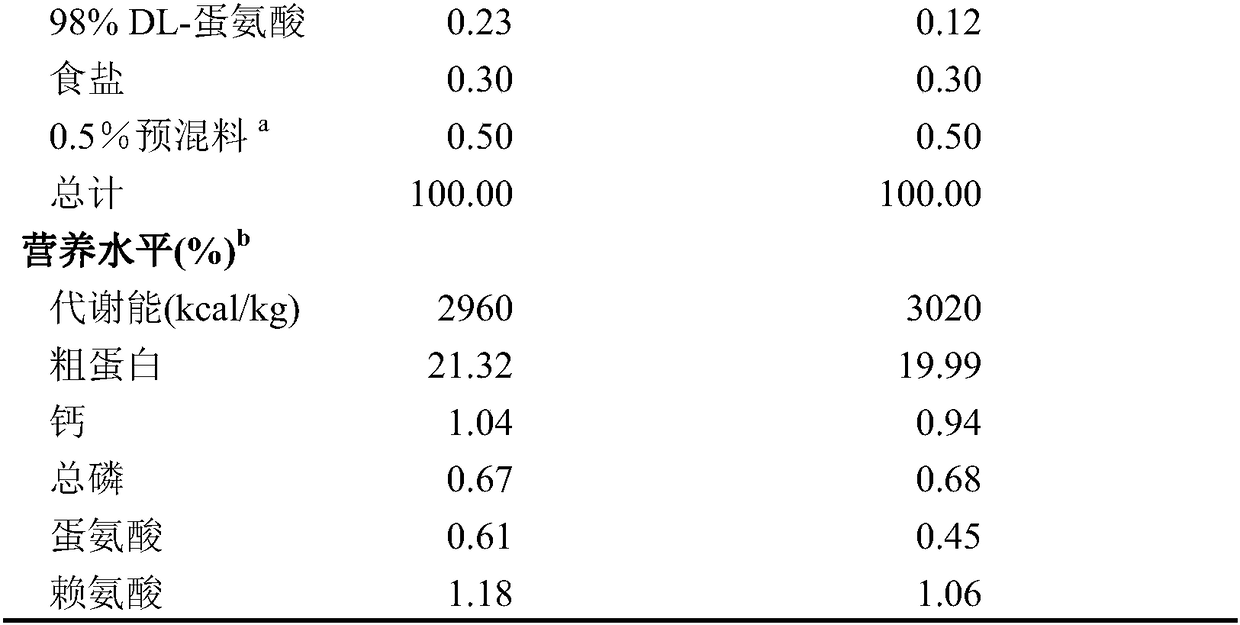Application of bile acid in preparing feed additive for broiler chickens
A feed additive and bile acid technology, which is applied in the application field of feed additives, can solve the problem of insignificant effect of digestibility, and achieve the effects of improving slaughter performance, reducing death rate, and preventing fatty liver and hepatobiliary syndrome.
- Summary
- Abstract
- Description
- Claims
- Application Information
AI Technical Summary
Problems solved by technology
Method used
Image
Examples
Embodiment 1
[0028] Example 1. Experiments on the effectiveness of adding bile acids to broiler chickens in the 0-21 day diet
[0029] 1. Materials and Methods
[0030] 1.1 Test substance
[0031] The bile acids used in the test were provided by Shandong Longchang Animal Health Co., Ltd., specifically including: hyodeoxycholic acid 8.00%, hyodeoxycholic acid 70.67%, chenodeoxycholic acid 19.61%.
[0032] 1.2 Experimental animals and design
[0033] The test selected 432 AA broiler chickens with an average initial body weight of 43.18g at 1 day of age, and randomly divided them into 4 treatments, each treatment had 6 replicates, and each replicate had 18 chickens. The diet of the control group was corn soybean meal type diet. The test was divided into two stages: 0-21 days and 22-42 days. The basal diets of the four treatment groups were added: 0, 40, 60 and 80 mg / kg of bile acids in the early growth period (0-21 days).
[0034] 1.3 Test diet
[0035] Corn-soybean meal-based rations w...
Embodiment 2
[0086] Example 2. Evaluation of the effectiveness of adding bile acids to broiler chickens in 22-42 day diets
[0087] 1 Materials and methods
[0088] 1.1 Test substance
[0089] With embodiment 1.
[0090] 1.2 Experimental animals and design
[0091] The test selected 432 AA commercial broiler broiler male chicks with an average initial weight of 43.05g at 1 day of age, and randomly divided them into 4 treatments, each treatment had 6 replicates, and each replicate had 18 chickens. The diet of the control group was corn soybean meal type diet. The test was divided into two stages: 0-21 days and 22-42 days. The 4 treatment groups added 0, 40, 60 and 80 mg / kg of bile acids to the basal diet at the late growth period (22-42 d).
[0092] 1.3 Test diet
[0093] With embodiment 1.
[0094] 1.4 Feeding management
[0095] With embodiment 1.
[0096] 1.5 Measuring indicators and methods
[0097] 1.5.1 Growth performance
[0098] With embodiment 1.
[0099] 1.5.2 Slaughte...
Embodiment 4
[0181] Embodiment 4, repeated verification test of bile acid in the production of 817 broiler chickens
[0182] Subjects of the experiment: 817 broiler chickens in Tianzhai Village, Gaotang, 5450 birds, were randomly divided into two treatment groups, blank control group (1450 birds) and test group (4000 birds).
[0183] Experimental method: In the same shed, two water lines were used for the control group and the test group respectively. The test started at 10 days old (July 13, 2014) (it is recommended to change to 1 day old if it is for customers to see), and ended at 48 days old (2014-8-19), a total of 38 days. Longchang bile acid in the test group drank 150g / T of water until the end of the test, and the control group was blank.
[0184] Experimental results: The number of 817 broiler chickens in each group was recorded in detail, the number of slaughtered, the weight of slaughtered, feed intake, and the mortality rate. (Chickens are infected with influenza virus at the ...
PUM
 Login to View More
Login to View More Abstract
Description
Claims
Application Information
 Login to View More
Login to View More - R&D
- Intellectual Property
- Life Sciences
- Materials
- Tech Scout
- Unparalleled Data Quality
- Higher Quality Content
- 60% Fewer Hallucinations
Browse by: Latest US Patents, China's latest patents, Technical Efficacy Thesaurus, Application Domain, Technology Topic, Popular Technical Reports.
© 2025 PatSnap. All rights reserved.Legal|Privacy policy|Modern Slavery Act Transparency Statement|Sitemap|About US| Contact US: help@patsnap.com



